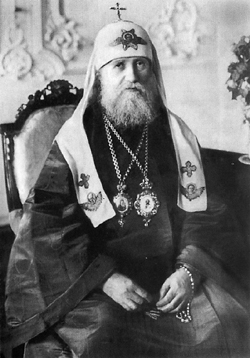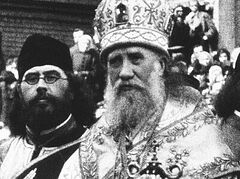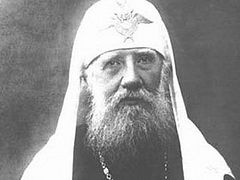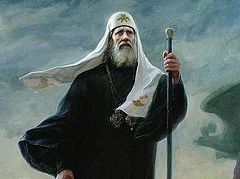Perennially in Russia, the subject comes up, usually around Christmas, of Patriarch Tikhon’s almost switching the Russian Church’s calendar from the Julian to the Gregorian. The author here discussed just how valid the claims are that the Holy Patriarch was a supporter of the New Calendar.
 [One Moscow archpriest] said, in part, “In 1923, there was an attempt to change to the same [Gregorian] calendar by Patriarch Tikhon. But one year before this attempt, the ‘renovationists’ (a fifth column within the Russian Church, artificially created by the Bolsheviks) had tried to do it. Therefore, the reform turns out to have been compromised, and the Patriarch was forced to abandon it…”
[One Moscow archpriest] said, in part, “In 1923, there was an attempt to change to the same [Gregorian] calendar by Patriarch Tikhon. But one year before this attempt, the ‘renovationists’ (a fifth column within the Russian Church, artificially created by the Bolsheviks) had tried to do it. Therefore, the reform turns out to have been compromised, and the Patriarch was forced to abandon it…”
In connection with this, it seems necessary to turn to historical sources, and research the question as to how Patriarch Tikhon’s really related to the New Style.
A whole series of events was undertaken by the GPU in order to compromise the Patriarch in the eyes of the faithful. One of the requirements for the Patriarch was to begin to offer prayers in churches for the Soviet government, and to introduce a new chronological style.
There are a number of documents in the materials of Patriarch Tikhon’s investigative case that allow us to revise the well-established idea in the literature that Patriarch Tikhon made great concessions to the authorities and was a supporter of compromise with the Soviet government. Metropolitan Peter (Polyansky) described the Patriarch’s position very accurately in September 1924. In a private conversation with one of the priests, who presented himself as a supporter of the Patriarch but who was actually a Renovationist, and through whom these words became known to the GPU: “As for our transition to the New Style, your alarm is completely in vain; skillfully tell all your comrades and parishioners that we will never switch to a new style, because the people do not want it. But we might be forced to change by the civil authorities, and then we will submit and issue an epistle accordingly. But pay no attention to this, and consider such forced (highlighted by DS) epistles to be unobligatory. Secretly, whispered in the ear, through reliable persons, you will explain to the faithful that His Holiness is currently in terrible conditions, precisely between a hammer and an anvil. On the one hand it is necessary to submit to the civil authorities, and on the other, in church affairs they can in no way be obeyed, because it is a godless regime and is leading to the destruction of the church; and we will not enter into conflict with the masses, otherwise they will go to the Renovationists. But you yourself know that these Reds are the same godless Bolsheviks. So do not be troubled, our position is solid, and the Renovationists are getting weaker and weaker every day.”1 These words of St. Tikhon are very important for understanding his actions during this period.
These words concern any epistle about transition to the New Style, but they equally apply to all other epistles of the Patriarch that he issued in response to the demands of the authorities. The Patriarch’s tactic was that, in response to threats of reprisals against the Church, he issued the necessary epistles to the authorities, in which, as a rule, the demands of the authorities were reflected only partially; but in fact there was no intention to fulfill these requirements, and in private conversations he spoke of the coerced nature of these epistles—which, however, the faithful understood without explanation. As one of the people closest to the Patriarch, Archimandrite Alexy, the vicar of Donskoy Monastery, said about the epistle on the New Calendar: “Anyway, the people will not go for it, because we will tell some of our own that the Patriarch sent the message not of his own will, but under pressure. And we will bless everyone to celebrate feasts according to the old style. We have already thought this through. On all Church holidays according to the old style, we will serve without ringing or we will ring on a weekday and the people will still come to us; they will not condemn us for this, because they will understand that we are in a vise grip.”2
One of the main requirements of the head of the “church” department of the GPU, Yevgeny Tuchkov, was the introduction of the New Style into liturgical life. On September 18, 1923, the Anti-Religious Commission in a meeting resolved: “To recognize as expedient that Tikhon and K-o, first of all, actually implement the New Style in the Church, put an end to parish councils, and introduce second marriage for the clergy. For doing this, they will be allowed to publish a periodical.”3 The introduction of the New Style, according to Tuchkov’s plan, could have caused a serious split in the Patriarchal Church, since the new style was strongly associated with Renovationism in the minds of believers. One of Tuchkov’s arguments was that in 1923, a “Pan-Orthodox Church Congress” was held in Constantinople under the chairmanship of the then Patriarch of Constantinople Basil, at which the majority vote resolved to introduce the New Calendar into the liturgical life of the Orthodox Church. A copy of this resolution was handed to the Patriarch, but the fact was hidden from him that this resolution was not adopted by the Eastern Patriarchs and Patriarchates. The authorities argued for the introduction of the new style of worship out of economic need: many workers celebrated Church holidays in the New Style officially and in the Old unofficially, and this caused mass absenteeism.
On September 24, 1923, a meeting of bishops chaired by the Patriarch decided to urgently adopt the New Style in church life, but to introduce it so that the upcoming Christmas Fast actually embraced the fully lawful period of forty days, and therefore actually began on November 15 according to the Gregorian calendar (November 2 in the Julian). An epistle was drawn up about the transition to the New Style, stating it was based on unity with the Orthodox Churches of the East. The message was read on October 14, New Style, during the patriarchal service at the Moscow Protection Monastery. Moreover, the decrees on the introduction of the new style were sent only to the deans of Moscow, and the diocesan bishops did not receive them, since Archbishop Hilarion asked Tuchkov for permission not to send these decrees to the provinces until the patriarchal epistle explaining the decree was printed. V. Vinogradov notes that the new style was officially announced and introduced only in the churches of Moscow, and nowhere else.
The Patriarch’s epistle about the introduction of the New Style was the same “forced epistle” as the previous ones. The materials of the investigative case confirm that the Patriarch was not really going to switch to the New Calendar and was only waiting for a convenient moment for its official cancellation. Thus, in the “Report on the activities of the Tikhon group for the month of October 1923”, compiled by the Moscow Department of the GPU, it was said that the Patriarch “serves Church feasts by invitation, both when they are served according to the new style, and the old style.”4 The Patriarch’s services on the feasts according to the Old Style would have been impossible if he had consistently sought to introduce the New Style. This is also indicated by the fact that the Patriarch’s epistle about the transition to the New Style was not sent out, and the words quoted above by Metropolitan Peter (Polyansky) that the Patriarch will never switch to the New Style say the same thing. In addition, Archpriest V. Vinogradov points to the fact that the Patriarch instructed that his epistle be read in the church of the Protection Monastery by Archpriest V. Vinogradov, who had a quiet voice, so that it would not be heard.5 Archbishop Hilarion (Troitsky) also preached explanatory sermons in Moscow churches, so that in one of the summaries of the GPU “Notes on Religionists.” it was noted that at the end of October 1923, he preached a sermon in the Church of the Nativity of the Theotokos on the topic, “The New Style. The immutability of the Orthodox faith henceforth.” After the service, as stated in the document, “they carried him to the cab on their hands.”6 Such an enthusiastic reaction would have been impossible if the archbishop had shown himself to be a supporter of the New Style. The Patriarch understood that in order to introduce the New Style in the provinces from November 15 (N.S.)—and this was necessary in order for the Christmas fast to retain its 40 days—it was necessary to send epistles on the introduction of the New Style to those locales by November 1–3. This was not done—on the one hand because the printing house did not print the epistle by the beginning of November, and on the other hand because the Patriarch himself did everything possible to prevent this epistle from being sent out.
Meanwhile, during this period, at the initiative of E. Tuchkov, a message appears in the press that the “Pan-Orthodox Congress”, which decided to introduce the New Style, was of a renovationist nature. This was done in order to “expose” the Patriarch as a Renovationist and compromise him.
Taking advantage of the fact that the message was not printed by the beginning of November, the Patriarch issued an order on November 8, 1923, in which he ordered to postpone the introduction of the New Style.7 However, the opinion of Archpriest V. Vinogradov seems to be incorrect, that it was only this circumstance that led to the cancellation of the New Style. As was shown above, the Patriarch did everything to ensure that the New Style was not actually introduced. An active assistant of His Holiness in this was the Holy Martyr Archbishop Hilarion (Troitsky), whose holy relics are now in Sretensky Monastery.
The cancellation of the decision to introduce the New Style was an unpleasant surprise for Tuchkov; perhaps this was one of the reasons why Archbishop Hilarion (Troitsky) was arrested on November 15, and sent to a concentration camp. In fact, his courageous defense of the Julian calendar in the Church cost the Holy Martyr Hilarion his life.
On November 20, the Anti-Religious Commission, for whom the return to the Old Style understandably caused dissatisfaction, resolves: “A) Instruct Comrade Tuchkov to implement the New Style through Tikhon and cancel the reintroduction of the old; B) Instruct him to urgently put up and distribute Tikhon’s proclamation about his introduction of the New Style.8 Tuchkov tried to spread the appeal, but it did not have the proper effect.
In December 1923, Tuchkov published a fake epistle on behalf of the Patriarch, in which it was reported that the Patriarch had not canceled the New Style he had announced, but that it was allowed locally, with the consent of the local Soviet authorities, to celebrate the upcoming feast of the Nativity of Christ also according to the Old Style. As Archpriest V. Vinogradov testifies, he was unable to establish the origin of this document, because it did not pass through the Patriarchal Administration, was not sent to anyone, and is known only by newspapers. This document had no practical application in church life. Prot. Vinogradov assumed that “this document, drawn up by someone hastily, was needed by Tuchkov to obscure the complete failure of his machinations in an attempt to impose the New Style on the Patriarchal Church in front of some higher Soviet bodies.9 This document is interesting because this is the first publication of a forged document undertaken by the GPU on behalf of the Patriarch.
By this time, the Patriarchal Church had managed to strengthen significantly. As noted in the report, “Activities of the Tikhonites”, prepared by the 2nd department of the Secret Part of the Moscow City Department of the GPU: “In Moscow, the Tikhonites have more or less successfully dealt with renovationism”.10 All attempts by the GPU to discredit the Patriarch ended in failure; therefore, from mid-November 1923, the GPU changed its tactics and switched to a policy of repression, without abandoning its attempts to discredit the Patriarch.
Thus, from the above it is obvious that Patriarch Tikhon not only was not a supporter of the introduction of the New Style in the Church, but also, together with the Holy Martyr Hilarion (Troitsky), did everything to ensure that, despite enormous pressure from the authorities, the New Style was not introduced in the Russian Orthodox Church.




